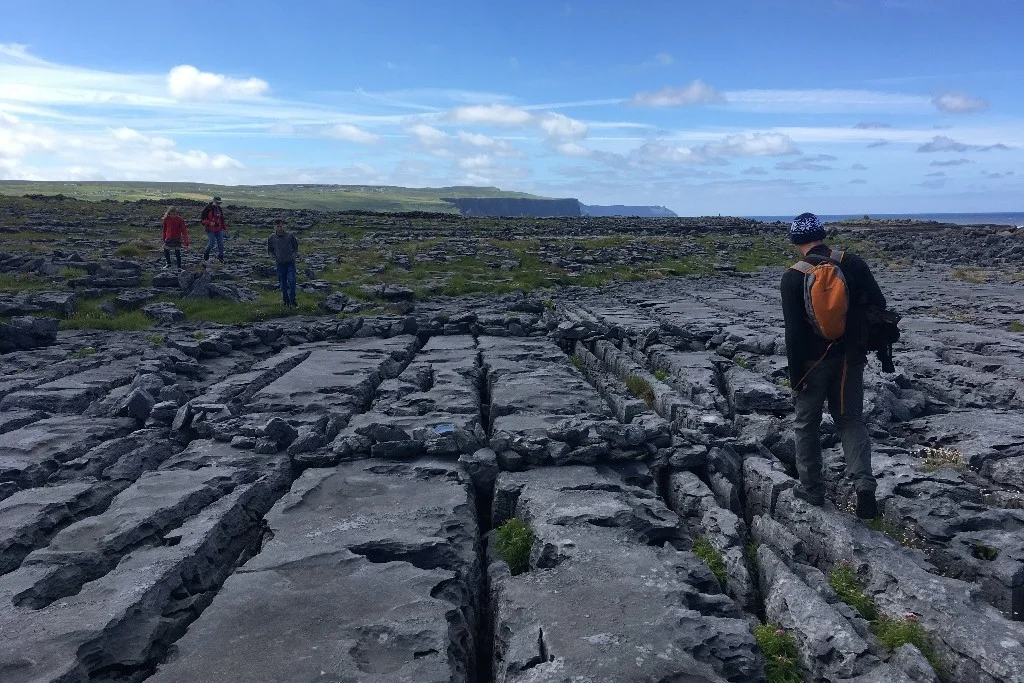The lavender hills. A few days ago I joined a valiant brigade of walkers across a northern part of the Burren. Every Sunday, whatever the weather, they hike the hills. Along the way there were many conversations: living in the Burren, walking the camino, education in Ireland, Syrian refugees in County Clare towns, Irish politics, music, history, Tasmanian devils and Burren geology and botany. We walked up and across the limestone pavement, past several medieval ecclesiastical sites: Corcomroe Abbey (1194), Colman’s holy well, and the Oughtmama churches. Monastic and church sites in the Burren seem almost as profuse as the wildflowers. The stories lying latent are various, many tragic, such as the graves of children who were not baptised and the deaths of teachers of hedge schools caught by the redcoats for delivering illicit education to children (in the seventeenth century).
To be here in spring is to be surprised by colour at almost every step: in gaps between rocks, under walls, beside pathways. Hawthorn is abundant, festooning fields and roads in white and pink clusters. As May moves towards summer, wildflowers decay on the slopes and valleys yet are still resplendent: spring gentians, orchids, bloody crane’s bill, hawthorn, primrose, dog-rose, wood anenomes, mountain avens, wild strawberry, cowslip, bird’s foot trefoil, dandelion, germander speedwell and many more with wondrous names. Walking and looking has many rewards. After Sunday’s walk I purchased a guidebook to wild plants of the Burren. I’m gradually coming to understand differences with Tasmania’s unique ecology and the need for informed stewardship in both places.
The Burren is a Geopark, one of a network of important Geoparks in Europe. BurrenLIFE, a program funded by the EU, has been nominated for a Green award for its “phenomenal impact on a unique landscape.…[because it has] pioneered a novel approach to farming and conservation…with alternative approaches to sustainable management of high nature value farmland.” Its premise is building a sustainable relationship between agriculture, community and ecology. It is educating farmers and businesses towards bringing into focus the uniqueness and fragility of this environment. BurrenLIFE, in process now for 20 years, works from a simple principle: cattle are taken to limestone uplands in winter to eat down the grasses instead of being fed silage gleaned from fields. Reducing growth on the hills by grazing favours the wildflowers’ appearance in spring when cattle are returned to the lowlands. Farmers are rewarded financially if they support the scheme by not overgrazing, maintaining the stone walls, controlling overgrowth and reducing use of silage.
Grazing in winter on uplands seems counter intuitive and in reverse to other European countries with traditions that transfer cattle to highlands in summer; and in Australia cattle are reported to be totally destructive in fragile alpine reserves. What has been highlighted to me here is that ecology is niche- and place-specific: it needs stewardship that is unique to that land. Wintering of stock in the Burren has seen the return of bio-diversity and a deep pride in land care. Diversity here has a broader meaning than in Tasmania where endemic species are seen as necessary to protection and everything foreign excluded. Here conservation and biodiversity has a broader agenda. Dialogue with those who live there, or who have deep ancestral connections, may take time but is richly rewarded.
The Burren in Bloom festival (for two weeks) and the Burren Marathon (this weekend) offer a plethora of choices for visitors and locals in May. A real joy for me was attending a reading at BCA by Belfast-born poet Michael Longley, contemporary of Seamus Heaney and winner of many poetry awards. He chose poems of place and all referred to flowers, many he had found in the Burren. His gentle and meticulous poems speak to his love for this wild garden as well as to the pain of experiencing the Troubles in Ulster when he lived there. I was deeply moved by this poet’s reading, particularly since my recent trips to Belfast and County Derry have established a vibrant connection through family with Northern Ireland.
The singers in the whiskey bar last night spoke of the sadness so many of us were feeling following the Manchester bombing this week. So many Irish know that city well. Songs from the American songbook of the 70’s and 80’s dominated the visiting singers’ choices. Irish songs, sung by a couple of regulars, men in their 80’s, were of work, love and loss: poignant and memorable. I wondered about singing Lee Marvin’s “I was Born under a Wandering Star” and Don McLean’s “Bye Bye Miss American Pie”, songs that I didn’t rally to when they were popular but last night gave us all opportunities to sing together. The goodwill of the song leader was evident: to raise hope and deflect depression after so much unnecessary loss. Let the flowers bloom: Burren gentians, dandelion, hawthorn and Tasmanian laurel, scoparia and the brilliant fagus leaves.
My time here is closing in. In two days I will be returning to the Southern Hemisphere, to Tasmania’s mild winter. Daylight will diminish. Here light is like an endless festival, birds its constant chorus. I will light a fire, sing and play Bach, improvise inside and outside, marking my return with the sounds and silence trawled from my brief time in Ireland’s arms. My memories of the Burren residency will be of many hues. I’ve taken this place deep into my being and I’m so grateful.
BurrenLIFE:
Fern on the uplands limestone
Hawthorn near the ruin of churches
Gentian
Burren clints and grykes in its karst landscape



